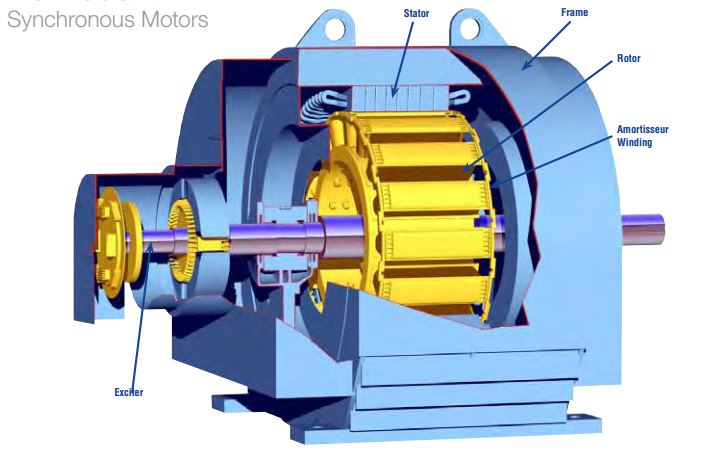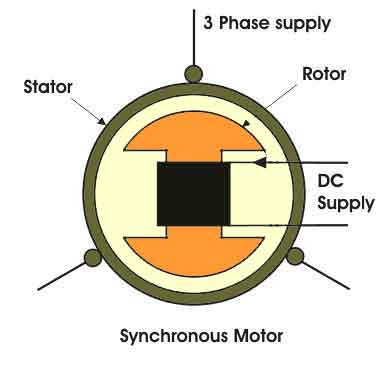
In this article, I will share the Introduction to synchronous motor with you guys. First things first, I am telling you about its construction and working in first two segments of my article. While later I would be throwing some light on its key features followed by methods of starting and areas of application. So, let's have a look at Introduction to Synchronous Motor:
Construction - Introduction to Synchronous Motor
- In Introduction to Synchronous Motor, we will first talk about the construction of synchronous motor.
- Talking about its construction, the basic structure is same as of other motors.
- Stator and rotor are the main parts while frame is the cover.
- Stator and rotor both make up the electric and magnetic circuitry of Synchronous motor.
- I will tell you about the stator first:

Stator of Synchronous Motor
- As the name suggests, stator is the stationary part of motor.
- It is the outer frame which is cylindrical in shape.
- This cylindrical frame is laminated and has slots to carry winding circuitry
- Stator of this motor is supplied 3 AC power.
- The winding circuit of stator is called stator winding.
Now, I will tell you about the rotor of a synchronous motor.
Rotor of Synchronous Motor
- Rotor is the rotating part, which rotates exactly at the same speed as the stator magnetic field.
- It is also cylindrical in shape and it is the shaft of the motor from where output load is connected.
- It rotates in the stator frame which is separated by an air gap.
- Rotor of a synchronous motor is excited by a DC source.
Frame of the motor protects and cover the whole assembly. It can either be built in vertical or horizontal shape and the type of covering depends on its area of use. That was all about construction of a synchronous motor. The next on my list in Introduction to Synchronous Motor is working principle and operation of this motor.
Working of Synchronous Motor
Let’s now talk about the working of these motors briefly. The operation of a synchronous motor is basically that the rotor tries to follow the rotating magnetic field of stator and rotates at a speed approaching to it. This motor is a doubly excited machine. The rotor winding is excited by a DC source while the stator winding is excited through an AC source. A 3 phase rotating magnetic field is produced by stator winding due to 3 phase AC. And a constant magnetic field is produced by rotor winding.
At some instant of rotation, the poles of two magnetic fields may attract each other while at some other instant, they repel each other. The rotor will not start rotating due to these interactions due to its inertia. So an external mean will compensate and provide initial rotation to the rotor. Once the rotor starts moving at the synchronous speed, this external source is shut off.

Key Features of a Synchronous Motor
In this segment of my article, I am sharing some features of this type of motor which differentiates it from other motors.
Speed
- Generally, the speed of ranges from 150 rpm to 1800 rpm. The speed remains constant from no load to full load and can be found from the following formula:
N_s = 120 * f / p
Where f = frequency of AC supply
p= no of poles
The speed is synchronous speed. It does not depend on load conditions.
Starting Torque:
- Synchronous motors need some external method for starting as it has no starting torque. The next section of this article gives the commonly used methods to start it.
Rating
- The power rating of synchronous motors is 150kW to 15MW.
Efficiency
- Synchronous Motors are highly efficient machines. Their efficiency is much greater than induction motors.
Cost
- Synchronous motor is costly as compared to induction motor of same rating.
Power Factor Correction
- Synchronous motors have a leading power factor therefore used in areas where power factor correction is needed.
Maintenance
- This motor uses brushless excitor which decreases the maintenance problem of this machine.
Now, I am moving towards last two parts of this Introduction to Synchronous Motor, where I am going to share some knowledge about the methods of starting and uses of these motors.
Methods of Starting a Synchronous Motor
As I told you earlier in my section on key features, synchronous motor cannot self start as it has no starting torque. Therefore to overcome this problem different ways are used. Some external mean is used at start for bringing up the speed up to synchronous speed. The three main ways are as under:
- Reducing frequency of stator to a safe starting level.
- Using external prime mover.
- Using damper windings.
These are the ways which are used to start a synchronous motor.
Uses and Areas of Application
Introduction to Synchronous Motor won't be complete unless we have a look at its uses and areas of Application, I am sharing some of the uses of synchronous motor which are given below.
- The basic use of a synchronous motor is “power factor correction” that means to increase the power factor of a system.
- Synchronous motors are also used in voltage regulation. For example, they are used at the end of transmission lines to regulate voltage.
- Synchronous motors are commonly used for low speed, high power loads. Their application area is constant speed constant load drives.
- With VFD (variable frequency drive), synchronous motors are used to attain a range of speeds.
- Synchronous motors are used in air and gas compressors and vacuum pumps.
- They are also used in blowers, exhausters and fans.
- Such motors also find their application in crushers, mills and grinders.



